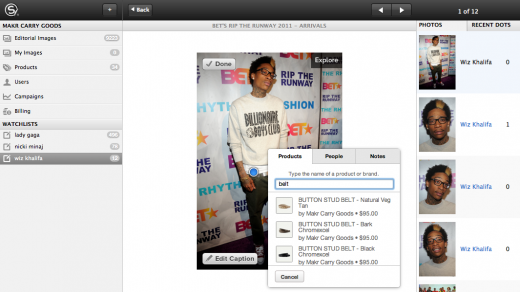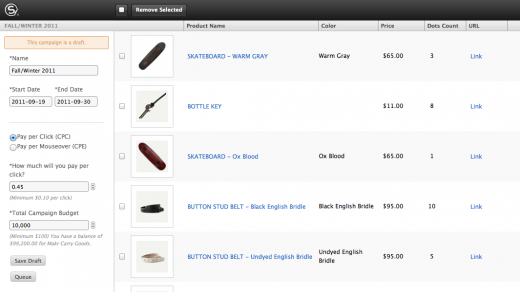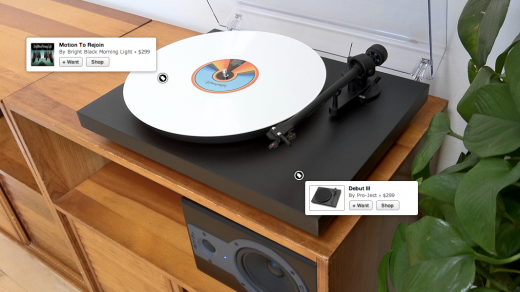
Imagine that your brand has the power to own and individually advertise over every single image your product might be featured in. Or imagine instead that as a publisher, any photo you use on your site now has the potential to earn you money because it already belongs to a set of brand-owned and tagged images.
This is the power of San Francisco-based Stipple Marketplace, which bills itself as “the definitive image discovery and licensing service creating the web’s most valuable, interactive images.” Launching today, Stipple Marketplace is an effective, clean and non-intrusive way for advertisers and publishers alike to use any photo to create interactive picture-advertising.
Instead of paying to license images and then running ads to hopefully offset the image’s cost, publishers can now license photos pre-loaded with revenue and interactive, searchable content.
In this way, Stipple hopes to put control back into the hands of photo owners, enabling them to measure a photo’s advertising performance while monetizing and engaging its viewers at the same time.
How does it work?
While it certainly has the potential to work for just about anyone, Stipple Marketplace is currently most beneficial to content publishers and content advertisers. To understand how it works, let’s break the service into three different groups: Advertisers, Publishers, and Consumers.
Advertisers
Just for an easy example, let’s say The Next Web is an advertiser. TNW happens to have a photo of Justin Timberlake (again, just an example) wearing one of TNW’s branded tee-shirts. For any brand, this situation presents itself as an opportunity to potentially make money through the photo, where the image serves as an effective advertisement for the celebrity-worn shirt. Stipple Marketplace provides the tools to make this happen.
To begin, TNW heads into the Stipple Marketplace and uploads its Timberlake photo. With the image in the system, TNW now owns the image and can set about individually tagging the different elements of the photo with smart fingerprinting. In this case, the goal would be to sell the shirt worn by Timberlake in the picture. TNW simply needs to tag and label the shirt itself with additional information, and potential consumers can now just click on the individual tag to jump to where the shirt is being sold.
While TNW will be using this interactive image on its own site to better direct consumers to Timberlake-shirt-purchasing-glory, third party publishers can also take the branded photo and place it on their sites as well, earning themselves money in the process simply by using that branded photo pre-loaded with smart image tagging.
TNW can then decide whether it wants to pay publishers by how many times a Stipple image tag is clicked, or by how many mouseovers a tag gets. It can actually do this for several photos it chooses to brand and smart tag.
Tadaa. TNW has just created its first interactive image campaign, and all through a simple photo uploaded to Stipple Marketplace. The possibilities here are endless, as TNW can now upload as many photos as it likes to the service and potentially brand and tag all iterations of its presence across various pictures, now being able to effectively advertise on top of any image it owns.
Publishers
For publishers, the Stipple Marketplace process is even easier. Let’s pretend, in this example, that you are a blogger looking to generate some easy revenue. Stipple Marketplace provides you with a simple line of javascript to insert anywhere on your site. This javascript will enable Stipple’s smart tags and interactive advertisement fingerprinting to work across the entire scope of your website’s media library, converting every photo pre-loaded with Stipple tags into an advertisement.
It’s that easy.
Now, every single photo on your blog has the potential to make you money. In the event that an advertiser has no pre-existing and branded photos to upload or use, both publishers and advertisers have the option to select from the millions of pre-uploaded photos already in the Stipple Marketplace in order to iterate on top of them.
Marketplace, the new image discovery tool for content contained in Stipple’s Media Cloud, enables bloggers and publishers to search for and find real-time news, sport, celebrity, entertainment, and stock photos. Marketplace launches with more than 1 million images from many of the world’s leading photo agencies and companies, and receives over 10,000 new images daily. Stipple offers images that are not simply cost centers for publishers; instead Stipple images can generate revenue and pay publishers for audience and engagement.
The amazing part is that no matter what size an image takes (some blogs have a max image width of 600 pixels, for example, while other blogs use tinier images at widths of 220 pixels), Stipple tags are smart enough to work across all scales and sizes.
Consumers
The consumer viewing a Stipple’d image will notice that hovering over any image preloaded with smart fingerprinting will present them with a non-intrusive set of tags. The consumer can then mouseover these tags to reveal the information an advertiser has loaded them with, and scroll away to make these tags disappear if they aren’t interested in clicking through to discover more or make a purchase. Simple.
Stipple has the potential to completely disrupt image advertising. Assuming that all brands and advertisers begin to use Stipple Marketplace and that all bloggers or publishers embed Stipple’s easy-to-insert javascript, every image on the web has the potential to generate revenue and effectively convert viewers into customers. Publishers can now stop paying for photos, and start finding photos that instead pay them.
“The entire photo licensing model is dominated by oligopolies and broken. Professional photographers and small photo agencies end up struggling to make a living while publishers feel like they’re paying too much for photos. With Stipple Marketplace, we’ve aligned the interests of all parties — photographers, photo agencies, publishers, and brand advertisers — and enable each to generate revenue in a cohesive way.”
– Rey Flemings founder and CEO, Stipple
There are several creative ways to use Stipple’s smart tagging, and not all of it has to do with making a purchase. For example, brand advertisers can use smart tagging to link potential consumers to contests or Twitter accounts, or lead them to affiliated pages, etc. In the future, Stipple also has plans to incorporate people branding in the service, where Stipple Marketplace users can now tag public figures like Selena Gomez or, again, Justin Timberlake in a photo as well as whoever else might be worthy or of notable fame.
Image tagging is the future
The ability to take static content and make it interactive is a new technology that seems to be taking hold of the advertising world. Flemings hopes to do for images what Google has done for text — make them searchable and advertising-friendly. When imagining the entire scope of pre-existing images online that currently lack the sort of interactive advertising that Stipple offers, Stipple’s goal seems massive, but exciting.
In fact, assuming the company wants to move in this direction, Stipple also has the potential to reach beyond simply advertising and publishing by converting its entire media cloud library into a photo wiki of sorts where users can tag information in the photo to share with all other viewers. Its technology lends itself to a whole host of creative paths.
For more information on Stipple, check it out here.
Get the TNW newsletter
Get the most important tech news in your inbox each week.









